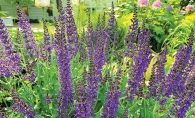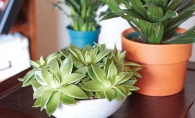Sandra Lester, a Hennepin County Master Gardener, bought her Plymouth home in 1967, seven years after it was built in an open field. Lester’s horticulturalist mother was amazed by this house “in the middle of no place,” so she worked with her daughter to encapsulate the house with trees and shrubs.
Today Lester’s yard is full of bushes and trees, but the landscape never stays the same for too long. A few years ago, a tree that was more than 100 feet tall had to come down, and its former location was suddenly sunny. This opening proved the perfect spot for a metal open-air gazebo, which is now the main accent in the back yard.
Lester grew up helping out with her mother’s commercial garden. After so much weeding and watering in her childhood, she never thought she’d want to garden again. But she couldn’t stay away.
She started with some small gardens when her kids were young, cultivating perennials and annuals in linear beds. But the gardens never seemed to be enough, and they expanded steadily. Lester didn’t aspire to her mother’s formal style from the ’50s and ’60s. She wanted hers to look like an English garden that had been there for years. So today, the gardens flow through fieldstone hardscaping from the front to back to side yards, with pathways in between.
Besides the gazebo, a pond and waterfall off the patio is another focal point. And a custom playhouse which also serves as a garden shed is an enticing spot, serving as the hub for various entertainments. The girls next door, as well as Lester’s own grandchildren, have taken it over since she had it made two years ago. The children enjoy the playhouse function, but Lester also has a wine cart out there, with some chairs for outside appetizers and a glass of wine or cup of coffee.
“I’ve always been outside. My mother gardened, and [I garden] for my sense of well being and spirituality. I’m not one who sits still or sits inside — I just have to be outside,” Lester says.
Lester’s garden, which will be featured in Midwest Home this summer, is mainly composed of pastel flowers, and she plants in threes and fives for impact. Her gentle palette is made up of a lot of phlox, roses, delphiniums and bee balm. The gardens are mostly perennial, accented with annuals. “Annuals have a big summer blast,” Lester says, “but perennials have a continuous flow of color from early spring to late fall.”
Lester recommends that casual gardeners start small. A huge garden all at once can get overwhelming. “If there are plants you don’t like, rip ’em out. Get something different. Don’t be afraid of the compost pile!”
And although Lester mainly gardens by herself, she says she feels “a garden is to share. I have a very large garden and I encourage my neighbors and neighborhood to just come and visit. I have people coming through my yard all summer long; they never have to call.”
Stephen Rutz, another Hennepin County Master Gardener, is also a lifelong gardener. His relatives all had big vegetable gardens, with farm and country backgrounds. But Rutz’s Plymouth land was wooded, so he never grew many vegetables there. When disease killed his big oak and elm tree and his property got sunnier, he ramped up the gardening. And when his kids went to college in 2004, he used his extra time to expand the gardens even more.
By the time Rutz was laid off from his IT job in 2007 he was tired of computers, and it was time to pursue something new. A career counselor asked what he wanted to do when he retired, and Rutz said he wanted to volunteer and get back into gardening. So he got a job working as a gardener/landscaper at Dundee Nursery and Landscaping Company, taking care of their five big gardens for eight or nine months of the year, a job he still enjoys.
Though Rutz was done working with computers, he did maintain a personal database. Since 2004, he’s used a spreadsheet to keep track of what he buys and where it’s planted. But gardens can be mercurial. Even with his system, he’s still not quite sure what’s thriving and what has disappeared — for example, he has at least two spreadsheet pages of lilies he’s planted, comprising 60 or 70 different varieties. He only feels certain about the location of 20 or 30 of those.
Besides being a master gardener, Rutz belongs to statewide societies focused on various flowers, as well as the Minnesota Horticulture Society. In 2016, one of his lilies was the Minnesota North Star Lily Society’s top show lily.
While experience and education have taught Rutz a lot about gardening, even a master gardener can have letdowns. “I don’t have a lot of luck with roses,” Rutz says. “I’ve got one rosebush in my yard that looks nice, but at least 10 rosebushes that I’ve planted and dug up and thrown away because they died on me for one reason or another.”
But even a novice gardener can have success if they start with the right plants. Since many Plymouth homes have shady yards, Rutz says hostas and astilbe can be good choices for local gardens. Peonies, though expensive to start with, are great because “you almost can’t kill them.”
Over the years, Rutz’s garden has continued to expand. He added a pond, waterfall and small stream in 2009, which are now central features of the backyard. He works at opening up his woods more every year, but says his garden is now about as big as he can handle. As he has run out of space for flowers, he’s begun planting more trees and shrubs to repopulate the woods that buckthorn removal thinned.
Rutz has put a lot of work into his yard and has plenty more to do. And though he has been gardening on and off his whole life, it hasn’t lost any of its charm: “I still consider it fun,” he says.









